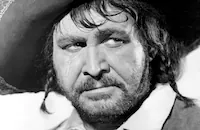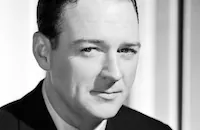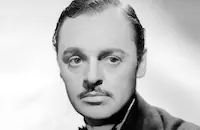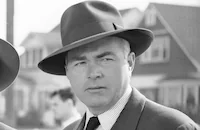You Only Live Once

Brief Synopsis
Cast & Crew
Fritz Lang
Sylvia Sidney
Henry Fonda
Barton Maclane
Jean Dixon
William Gargan
Film Details
Technical Specs

Synopsis
Eddie Taylor, a three-time convict, gets out of prison due to the influence of his fiancée Joan Graham's boss, public defender Stephen Whitney, who also is in love with Joan. Before he leaves, Eddie is warned by Warden Wheeler that a fourth conviction will result in a life sentence. Eddie and Jo marry, and at their honeymoon inn, they see two frogs next to each other in a pond. Eddie says that with frogs, if one dies, the other dies also, as they cannot live without the other, and Jo suggests that maybe they can see something in the other that no one else can see. That night, Jo and Eddie, who is skeptical that he will be accepted into society, are asked to leave their honeymoon room when the proprietors learn that he is an ex-con. Because of Stephen's influence, Eddie gets a truck driving job, but he is fired for being late after he meets Jo to show her a house they plan to buy. Needing to make the rest of the down payment by the end of the week, Eddie, although he is tempted to join his old bank robbing gang, desperately asks for his job back. When the unsympathetic boss won't even consider writing him a recommendation, Eddie slugs him. After his hat is found at the scene of an armored truck robbery in which six people, overcome with gas, have died, Eddie makes his way through the rain to the new house to see Jo before running away. She convinces him to remain and try to beat the rap, but he is found guilty and sentenced to die in the electric chair. When Jo visits him in prison shortly before he is scheduled to die, Eddie coldly asks her to get him a gun. Her attempt to bring him one sets off an alarm when she passed an "electric eye," and Father Dolan, the prison priest who had befriended Eddie during his earlier incarceration, gently takes the gun away. Jo asks Father Dolan to tell Eddie that she hasn't forgotten about the frogs. After Eddie finds a note hidden on the tray of his last supper stating that there is a gun hidden in the mattress of the isolation ward, he slashes his wrist with a tin cup and later causes a disturbance so that he will be put in that ward. Doctor Hill enters the ward with a guard, and Eddie, after finding the gun, takes Hill hostage. Using him as a shield, Eddie makes his way to the truck gate of the prison. Just then, a teletype message arrives for the warden ordering Eddie's pardon because his innocence has been established by federal agents. Eddie does not believe the warden when he tells him the news, and Father Dolan implores the warden not to open the gates for Eddie while he is carrying a gun, because he worries that Eddie will kill anyone on the outside who gets in his way. Dolan himself goes into the foggy yard with the teletype message. When Dolan refuses to give the order to open the gates unless Eddie hands over the gun, Eddie, no longer trusting anybody, shoots Dolan, whereupon Dolan, seeing that Eddie is about to shoot Hill, gives the order for the gates to be opened and dies. After he is wounded outside the gates, Eddie telephones Jo, who is just about to drink poison at the scheduled time of the execution. Stephen gives her money and his car, and she meets Eddie on a freight car. She steals medical supplies from a drugstore and, blaming herself for their predicament, refuses Eddie's plea that she leave him. After the couple is falsely blamed for robberies throughout the country, Jo has a baby and they travel North. At an auto court, Jo gives the baby to Stephen and her sister Bonnie to take care of until she sends for him and refuses Stephen's offer to send her to Havana while he tries to clear her name. A man at the auto court sees Jo buying cigarettes and calls the police. Near the border, Eddie and Jo come upon a roadblock, and officers wound both of them. They drive off the road, and Eddie carries Jo toward the border. Just after she dies in his arms, Eddie is shot. He kisses Jo and hears Father Dolan say, "You're free, Eddie; the gates are open," before he dies.

Director

Fritz Lang
Cast

Sylvia Sidney

Henry Fonda

Barton Maclane

Jean Dixon

William Gargan

Jerome Cowan

Chic Sale

Margaret Hamilton

Warren Hymer

Guinn Williams

John Wray
Walter De Palma

Jonathan Hale

Ward Bond
Wade Boteler
Henry Taylor
Jean Stoddard
Ben Hall

Jack Carson
William Pawley
Stanley Blystone
Malcolm Graham
Earl "hap" Hogan
Shirley Coates
Monte Vandergrift
Dutch Hendrian
Frank Mills

James Flavin
Ted Oliver
Dick Elliott
Don Brodie
Frank Hagney
Jack Cheatham
Ethan Laidlaw

Harry Cording
Jim Pierce
William Ruhl
Alan Bridge
Max Wagner

Lee Phelps
Bob St. Angelo
Earl Askam
Fred Warren
Lon Poff
Mickey Rentschler
Betty Ruth Huff
Lillian West
Claire Sinclair
Roberta Mountjoy
Mary Ann Durkin
George Burton
Bob Lee
Hooper Atchley
Katherine Clare Ward
Raymond Brown
Herbert Heywood
David Clyde
Stanley Price
Charles Wilson
Al Hill
Wally Maher
Allen Black
Al K. Hall
Edgar Dearing
Russ Clark
Crew
Hazel Adams
Graham Baker
Vance Griffith
Joe Kenny
Robert Lee
Frank Maher
Daniel Mandell
Robert Mitchell
Alfred Newman
Leon Shamroy
Isabelle Sheridan
Helen Taylor
Alexander Toluboff
Gene Towne
Walter Wanger

Film Details
Technical Specs

Articles
You Only Live Once
Fritz Lang's second American film, You Only Live Once (1937), is often characterized as among the very finest of his post-German career. In it he manages to achieve a rare balance between hard-edged social commentary, a moving love story, and expressive visual design. From the opening shot--an imposing, vaguely menacing view of a Hall of Justice--Fritz Lang indicates that he will question the nature of justice itself, or at least how justice is implemented in society. This is born out by the judgmental and callous behavior of ordinary people that Eddie and Joan meet after his release from prison. The hotel manager and his wife, inflamed by stories in sensationalistic "true crime" magazines, evict Eddie and Joan from their room on their honeymoon. The trucking company owner fires Eddie and talks casually on the phone with his wife about a card party while Eddie pleads for his job. Greedy individuals pocket cash register tills, claiming that the fugitives Eddie and Joan robbed them. Here Lang's cynical view of "the crowd" displays underlying similarities to the lynch mob in Fury (1936), his first American film, and to the panicky, quick-to-accuse populace in M (1931). At the same time, this film is enriched by a number of striking images, including Eddie and Joan's honeymoon conversation next to a frog pond, the devastating scene in which a newspaper prepares three different front-page headlines and photos of Eddie depending on the outcome of his court trial, the fogbound prison escape scene, and smaller details such as Joan drinking milk from a can pierced with a bullet hole.
Lang had been dissatisfied with his experience working at MGM on the film Fury due to studio interference such as an imposed happy ending. In that respect, it was fortuitous that he was able to make You Only Live Once with independent producer Walter Wanger. According to Lang biographer Patrick McGilligan, it was lead actress Sylvia Sidney who recommended to Wanger that Lang direct the project. The idea for the film came out of a dinner conversation between Wanger, Sidney and author Theodore Dreiser, during which Dreiser recommended that they do a story on Bonnie and Clyde. Lang was brought in as director after a draft of the script had been completed. Wanger agreed to let Lang have control over the final cut of the film, a privilege very rarely granted to directors in Hollywood. In his biography on Walter Wanger, author Matthew Bernstein notes that although Lang claimed at the time that Wanger refused to let him shoot a prologue depicting the "troubled environment" in which Eddie Taylor grew up, this assertion is questionable since no such prologue exists in the various drafts of the script.
Lang's notorious drive to control every aspect of a film was extended even to the acting; more than one person--including Henry Fonda, the film's male lead--has remarked that Lang treated his actors like puppets. Sylvia Sidney had worked with Lang previously on Fury and was more or less used to his methods. "I loved working with him because I loved the fact that he was so meticulous. He knew more about [the] camera, he knew more about cutting, and when he said he wanted just a close-up, [it was] very much like Hitchcock, it's what we used to call cutting in the camera." Later she would boast about being the only actor to survive three of Lang's films, the third being You and Me (1938). Lang's working relationship with Henry Fonda was far less smooth. Sidney recalls how Lang deliberately manipulated Fonda to get the desired results in terms of performance: "What he would do was take me across the set where Fonda was sitting, and would whisper in my ear. He had a thermos with homemade soup in it and he would pour some for me, all the time speaking softly. Well, Fonda knew that Fritz and I had worked together before, and he assumed that Fritz was giving me preferential treatment; giving me extra coaching, you know, that sort of thing. Well, Fonda would fume and mutter, 'That son of a bitch'...while all Fritz was doing was telling me how he had made the soup. And Fonda sort of said, 'The hell with him. I'll show him,' and he gave one hell of a performance."
You Only Live Once was not a great box office success during its initial release, but it was well received by most critics. Frank S. Nugent of The New York Times did not feel the film was as strong as Fury, but he did praise Lang's direction: "Mr. Lang's intuitive sense of camera angle, pace and mood raises it to dramatic stature...." However, the reviewer for Newsweek characterized the film as "the finest of its type since [The] Public Enemy [1931]", adding: "Given a stirring screen play by Gene Towne and Graham Baker, [Lang] directs it with the power and realism that characterized his work in M and Fury." Similarly, the reviewer for Time wrote, "You Only Live Once sets a pace which 1937 cops-&-robbers sagas may find hard to beat."
Producer: Walter Wanger
Director: Fritz Lang
Screenplay: Gene Towne and Graham Baker
Photography: Leon Shamroy
Art Director: Alexander Toluboff
Editor: Daniel Mandell
Costumes: Helen Taylor
Music Director: Alfred Newman
Cast: Sylvia Sidney (Joan Graham), Henry Fonda (Eddie Taylor), Barton MacLane (Stephen Whitney), Jean Dixon (Bonnie Graham), William Gargan (Father Dolan), Jerome Cowan (Doctor Hill), Chic Sale (Ethan), Margaret Hamilton (Hester), Warren Hymer (Buggsy), Guinn Williams (Roger), John Wray (Warden).
BW-86m.
by James Steffen

You Only Live Once
You Only Live Once
It co-stars Sylvia Sidney who first suggested Fonda for the role of "three-time loser" Eddie Taylor. Based very loosely on the true story of outlaws Bonnie and Clyde, You Only Live Once finds Taylor out of prison after his third jail term. The only good thing waiting for him is his lawyer's secretary Joan Graham (Sylvia Sidney), a naive girl who loves and trusts him blindly. However, as with so many of the film noirs of later decades, the hero cannot catch a break. Eddie and his new wife Joan are kicked out of their honeymoon hotel after the desk clerk finds his picture in a True Detective magazine. Then he is fired by a gruff boss looking for any excuse to rid his business of a "jailbird." Who can Eddie turn to but his old criminal gang? Will Joan stick by him as the world turns against him?
Independent producer Walter Wanger (Stagecoach, Invasion Of The Body Snatchers) initiated the production after a chance meeting with the famed author Theodore Dreiser who said he was then researching the story of Bonnie and Clyde for an article. Dreiser was not, however, used for the screenplay. Instead Wanger used his staff writers Graham Baker and Gene Towne. It was only then that Fritz Lang was brought in as director at the insistence of Sylvia Sidney. This was nothing short of amazing as Sidney had just finished working with Lang on the film Fury (1936), where American actors got their first taste of the brutal, exacting director.
Lang was on no better behavior during the shooting of You Only Live Once. Henry Fonda recalled how Lang directed a wedding supper, "He would dolly back and shoot, then he would stop and take the spoon from my dessert, move the ice cream round a little bit and dirty the dish, and then he would do it again, dirtying her dish a little bit, and then do it again. Then he would move the cup this way and do it, then he would tilt the marriage certificate and do it. He would do it fifty-five times, he would stand and blow smoke into the scene or something."
Fonda may have hated Lang's technique, but his acting obviously thrived under the director. His performance caused movie critic Pauline Kael to declare that neither he nor his co-star Sidney had ever been better. Fonda goes from beleaguered to frightening to transcendent while always remaining intense. Lang's direction matches him at every turn, as extreme lighting and subtle camera work create the oppressive atmosphere that ensnares Fonda's Eddie Taylor.
Image Entertainment's DVD has no extra features and the print, although excellent throughout almost its entire run, does show a few examples of print problems around reel changes. Undoubtedly, as with many independently produced films from Hollywood's Golden Age, original materials were not well preserved. Nevertheless, this film is a masterpiece that deserves to be on the shelf of anyone who appreciates both great acting and great directing.
For more information about You Only Live Once, visit Image Entertainment. To order You Only Live Once, go to TCM Shopping.
by Brian Cady
You Only Live Once
Quotes
Anywhere's our home. On the road. Out there on a cold star. Anywhere's our home.- Joan Graham
Trivia
Notes
The working title of this film was Three Time Loser. This was Walter Wanger's first film for United Artists. According to a Film Daily news item dated July 1, 1936, Spencer Tracy was originally scheduled to play a leading role along with Sylvia Sidney and Henry Fonda. New York Times articles on the production stated that director Fritz Lang, who worked with writers Gene Towne and Graham Baker for four weeks on the script, "tried to get into it what he called social implications that were ultimately overruled, showing how the boy drifted into crime because of bad influences and unfortunate environment-instead the picture opens as the boy emerges from the prison, a stranger to the audience." According to New York Times, once the script was the way he wanted it, Lang refused to allow the writers to alter it further. Correspondence in the Fritz Lang Papers at the AFI Library, including a letter from Towne to Lang, makes reference to a particular incident of conflict that occurred one night on the set. Towne, in a conciliatory tone, states in the letter that he realizes he and Lang are both "striving for perfection." In September 1936, Film Daily reported that Towne and Baker traveled to San Francisco to gather background material, presumably having to do with the prison scenes.
In an article dated November 8, 1936, during the production period, New York Times noted that Wanger "is permitting [Lang] to do just as he pleases and assures him that no other hands will touch [the film] through the editing, a condition that did not exist for Lang at Metro." (Lang's previous film Fury was produced by M-G-M [].) The article also pointed out that Lang "directs the setting up of the camera instead of leaving it largely to the photographer. Thus far the camera has not rested once on a stationary tripod, always being mounted on a crane, and when the characters aren't moving, the lens is." In a Hollywood Reporter article during production, columnist W. R. Wilkerson, after seeing four uncut reels, stated, "We have never seen anything so beautiful or so effective." According to a Hollywood Reporter news item, Wanger rented space at Educational to house a portion of the prison set which overflowed from the United Artists lot across the street. Hollywood Reporter also states that the song "A Thousand Dreams of You," by Louis Alter and Paul Webster, was purchased for this film and that Henry Fonda recorded the song on November 6, 1936. Fonda's singing does not appear in the print viewed, but it is possible that the music from the song is included in the soundtrack. Actor Charles "Chic" Sale died on November 7, 1936 from lobar pneumonia. According to Variety, he "gained world-wide fame by his delineation of rube character roles in vaudeville for many years, and more recently in pictures." A cast list in the Fritz Lang Papers at the USC Cinema-Television Library and Archive of the Performing Arts, gives the following credits for roles that were not in the print viewed: John Beck, Harry Bernard, Dorothea Wolbert (People in post office), Walter Soderling (Man in teller's cage), Frank Hammond (Lounger in store), Russ Powell (Sheriff in store). It is not known whether scenes with these actors were cut from the film, deleted from the print viewed, or not shot at all. According to the Lang Papers at AFI, the final cost of the film was $575,000, initial shooting took forty-four days, and a day each was needed for retakes, added scenes and inserts.
According to information in the MPAA/PCA Collection at the AMPAS Library, after the script was received by the PCA on August 17, 1936, PCA director Joseph Breen objected to the bank robbery scene, which, he noted, "will have to be very materially changed. The censor boards will not allow it. It likewise violates our Code, suggestively, at least, because of excessive brutality and gruesomeness." Specifically, Breen listed a litany of shots that were objectionable: "no flash of a man's face contorted with agony, no showing of a woman lying on the sidewalk, no hurling of bombs, no cop lying on the street, his face contorted in pain; no truck crushing out the life of a cop, no terrible screaming, no shots of bodies lying around, no figure of a little girl huddled in death, no shrieks." Breen also noted the similarity between the plot of this film and that of both We Who Are About to Die and The Turning Point (which was released as The Accusing Finger []) in terms of circumstantial evidence convicting a criminal and the sympathetic treatment of a Catholic priest. PCA information states that the print they received on December 31, 1936 was ten reels in length and 8,099 feet; however, retakes, additional scenes and inserts were shot in January 1937, and the footage of the final film has not been determined.
According to a telegram in the Lang Papers at AFI dated January 26, 1937, Wanger suggested to Lang, who had gone to New York to help with the opening there, that he assist the United Artists official in charge of dealing with the censor boards because certain censors were attempting to make cuts in the film. Lang himself cut the bank robbery scene for the state of Ohio censor board at the request of United Artists, but told them that Wanger was the one to decide if the film should be cut. Wanger later informed Lang that Ohio put the bank robbery scene back in. The Lang Papers at AFI contain a telegram in which David O. Selznick, praising the film, stated, "I think it one of the greatest directorial jobs I have ever seen." While reviews also gave the film high praise, Wanger, in a letter to Lang dated March 8, 1937, remarked, "I am afraid that the general reaction is that our picture is a little heavy for what they call 'entertainment' in this country." The story of this film was serialized in the Evening News beginning February 1, 1937. Extensive footage from the armored truck robbery was used in the 1945 Monogram production of Dillinger. That film contains some footage of the robbery not included in the print viewed of You Only Live Once and also shots from the earlier film of the armored truck being pulled out of the swamp and a long shot of the prison.














